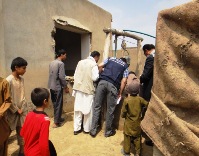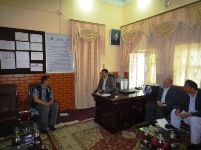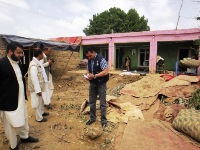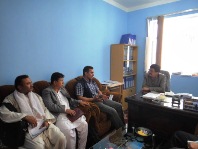 One of the major health concerns during floods is the risk of communicable disease due to interruptions in safe water and sanitation services
One of the major health concerns during floods is the risk of communicable disease due to interruptions in safe water and sanitation services
Heavy rainfall from 24 to 25 April 2014 resulted in flash floods across 10 provinces in northern, north-east and western Afghanistan. Initial reports indicate that Jawzjan province is the worst affected. According to the UN, more than 132 people have been killed, 27 000 affected and 16 000 displaced in Jawzjan, Faryab and Sar-e-Pul provinces as of 28 April.
Across the provinces, flood waters have destroyed homes, public infrastructure and roads. There are almost 40 facilities at risk in affected areas and initial assessments in accessible areas show that some facilities have been destroyed and health service delivery is being provided in temporary tents.
The Afghan Government’s Provincial Disaster Management Committees are leading the coordination of the response with support from WHO and international partners. Health officials, national emergency preparedness and response experts and WHO public health experts are in affected areas to determine needs, although limited access to some of the more heavily affected areas in Jawzjan remains a key challenge. UN agencies, nongovernmental organizations and the Red Cross movement are working in coordination with local authorities to ensure immediate delivery of emergency relief materials.
WHO is providing logistical support to the Ministry of Public Health’s Emergency Preparedness and Response committee and participating in missions to affected provinces to assess the health needs and gaps in response. WHO staff in Mazar have been in touch with the provincial health directors and visited the hospital to assess needs and gaps and determine response strategies.
To address immediate health needs, WHO has provided the Jawzjan Public Health Directorate emergency with medicines and supplies for more than 5000 beneficiaries. In Mazar and Faryab provinces, WHO has provided health kits for 40 000 beneficiaries, as well as kits for the treatment of diarrhoeal diseases.
Disasters such as floods can lead to the breakdown of diarrhoea and infectious diseases. Surveillance systems have been activated in all flood-affected areas with daily reporting of diseases. WHO has established zero reporting for disease outbreaks in affected provinces and is planning to implement a measles campaign for children from 6 months to 10 years on 12 May 2014. Additional disease early warning sentinel sites are being established to monitor disease outbreaks in areas where populations are displaced. A technical team from the Ministry of Health and a WHO expert are on the ground in Mazar-al-Sherif to re-establish the disease early warning system there.
One of the major health concerns during floods is the risk of communicable disease due to interruptions in safe water and sanitation services. An inter-agency assessment mission on water, sanitation and hygiene (WASH) led by UNICEF, and with the participation of WHO is underway in the affected areas.
Afghanistan floods, situation report, Issue 1, 26–30 April 2014 [pdf 413kb]
Photo gallery
 |
 |
 |
 |
 |


